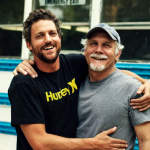Welcome home, Adrian: North Tahoe celebrates the return of pro mountain climber from Mt. Everest

Provided / Kayla Anderson
OLYMPIC VALLEY, Calif. – On Friday, June 14, friends and family gathered at Alpenglow Expeditions in Olympic Valley to greet professional mountain climber Adrian Ballinger who had just finished summiting Mount Everest last month.
“Everyone made it to the top, which is very unusual,” he says, explaining that there’s an average 30 percent success rate of people who attempt to climb the 29,032-ft. peak. However, Alpenglow Expeditions generally averages a 70% success rate.
There were only three teams that made it up to the top from the north side of Everest (from Tibet) this year, and of the three, the Alpenglow Expeditions was the fastest team—summiting and returning home in less than 30 days.
Ballinger explains that 150mph winds hit Everest 340 days a year, so there’s only a small window in May when mountaineers have the best chance of making it to the top. Alpenglow usually goes there in April to start climbing the smaller peaks around it and set up different camps.
In its 2024 Everest expedition, six clients, five mountain guides (from all around the world), and 12 Sherpas made it to the top. Another 10 people with Alpenglow made it halfway up the mountain as part of another pre-planned team. Its clients train 1-2 years beforehand to prepare for this enormous feat.
Going In from Tibet
Over the last couple of decades, Mount Everest gained a reputation of being overcrowded which has sadly added to its death toll. However, Ballinger says that is why he likes to go in from the northern Tibetan side instead of from Nepal. Tibet is harder to get into, but Ballinger has been climbing the Himalayas from this side since 2007. There were around 60 people who summited Everest from Tibet compared to the thousands who climbed up from the south, meaning no lines, no trash, and no waiting around while oxygen supplies dwindle.
This is also the first year that climbing Everest from Tibet has been available since the covid pandemic. “They closed Tibet in March of 2020, so we were one of the only teams able to get in. It’s more difficult to get permission, but it’s empty and pristine on that side. It’s more pleasant and much safer,” Ballinger smiles.
Ballinger founded Alpenglow Expeditions in 2008 in North Lake Tahoe and has been climbing Everest for 13 years. He was a mountain guide on the Nepal side from 2008-2014 and summited the world’s tallest peak nine times. However, the 2024 expedition was bittersweet for the Alpenglow team as it was the first time they were able to get on the mountain since the covid pandemic.
“Some clients have been waiting since 2019 to go. They paid their money and have been planning their lives around this, working around jobs, putting families on hold. People train for at least a year to physically do this, so it’s cathartic to succeed,” Ballinger says.
He explains that Covid was difficult for the business because they’d been going to Everest every year from 2008-2019 with no breaks and then everything just came to a halt, but in hindsight it was probably good that it happened that way.
“I realized how special these moments are to remember,” says Ballinger.
Training for Everest
When asked if it helps living in Tahoe to prepare for an Everest expedition, Ballinger replies, “There’s no advantage from an altitude training standpoint, but the community gives motivation to each other, people are always out there doing cool things. We always generally have great weather and a stable snowpack which helps. We get a lot of sunshine; this is an amazing place.”
The starting point of Everest is at 17,000 feet, which is a significant difference from Tahoe’s 6,225-ft. base elevation.
“The first base camp is at 17,000 feet and there are five camps to the top, one about every 2,000 feet from there,” Ballinger says. “We go up and down to acclimatize and set up our camps, climbing those mountains (around Everest) up and down multiple times,” he adds.
This year’s team consisted of a few Tahoe residents and some from the Bay Area, and Alpenglow clients get pre-acclimatized at home. Each year, people must be able to meet a set of qualifications to be considered for the trip.
“Seventy-five percent of people who ask about Everest aren’t ready,” Ballinger is clear about. “When they apply, they must have already climbed 3-5 twenty-thousand-foot peaks, one 23,000-ft. peak, and one 26,000-ft. peak.”
To train, usually people start on Mount Shasta (14,179 feet), take a few trips up Cotopaxi (19,347 feet), will climb Aconcagua (22,838 feet) in Argentina, and then start climbing the smaller mountains in Nepal. It’s important to Ballinger to have a strong team on Everest where everyone pushes their absolute limits to survive and help each other.
“You need to be an asset rather than a detriment. Can you cook? Can you set up a tent? Can you help a Sherpa if they need it instead of being a potential victim?” he asks his clients. It’s the reason why the Alpenglow teams are strong, and they’ve never had an accident in all of their years of climbing Everest.
“Ten to twenty people die a year on Everest, and we’re trying to provide a model where it doesn’t have to be that way,” Ballinger says.
Revelshine Welcomes Adrian Home
To welcome Ballinger home from Everest, Revelshine Wines hosted a party at the Alpenglow office in Olympic Valley. Ballinger is one of the 14 co-founders of Revelshine, and was joined at the party by his partner, pro rock climber, and fellow Revelshine co-founder Emily Harrington along with their 18-month-old son. Harrington met Ballinger summiting Everest in 2012 and is the first woman to free climb the Golden Gate route on El Capitan in Yosemite in less than 24 hours.
Head Revelshine winemaker/creator Jake Bilbro and local pro skier Michelle Parker also joined Ballinger in welcoming him back to Tahoe.
“It’s always fun to see people when we get home and drink good wine,” Ballinger says, lifting his cup of Revelshine California White. He says that after an expedition he always craves fresh vegetables and a good steak. In Tibet, Ballinger adds, “One thing to be successful is really good food,” explaining that once they get to Everest base camp, they have a Nepalese cook who was culinary trained in Switzerland.
“We eat really well– pastas, burgers, whatever people want—because once we get above base camp then weight (of food) becomes an issue,” Ballinger says. As they scale up Everest, it’s all dehydrated food at that point, and Ballinger says that you can’t eat, can’t sleep, can’t drink, and all food tastes terrible.
Just hearing that makes a sip of Revelshine taste like the best thing ever.
“I didn’t know we’d be able to summit—it’s never a guarantee—just to survive is a big accomplishment,” he smiles. “The unknown outcome makes the challenge so deep. There’s risk involved and a lot of suffering. But everyone’s equal on Everest and I think coming home, it makes me appreciate this place [Tahoe] more.” Alpenglow will be heading back to Tibet this fall to climb Cho Oyu, the sixth tallest peak in the world.
For those interested in joining the team, visit alpenglowexpeditions.com.
Support Local Journalism


Support Local Journalism
Readers around Lake Tahoe, Truckee, and beyond make the Sierra Sun's work possible. Your financial contribution supports our efforts to deliver quality, locally relevant journalism.
Now more than ever, your support is critical to help us keep our community informed about the evolving coronavirus pandemic and the impact it is having locally. Every contribution, however large or small, will make a difference.
Your donation will help us continue to cover COVID-19 and our other vital local news.










